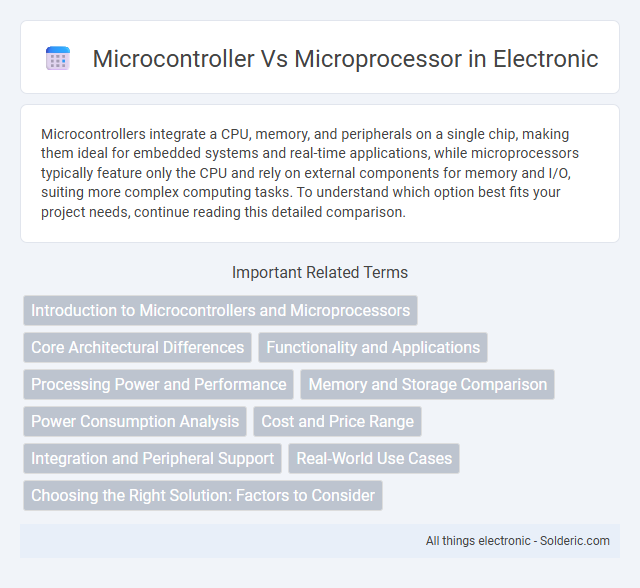Microcontrollers integrate a CPU, memory, and peripherals on a single chip, making them ideal for embedded systems and real-time applications, while microprocessors typically feature only the CPU and rely on external components for memory and I/O, suiting more complex computing tasks. To understand which option best fits your project needs, continue reading this detailed comparison.
Comparison Table
| Feature | Microcontroller | Microprocessor |
|---|---|---|
| Definition | Integrated circuit with CPU, memory, and peripherals | Central processing unit used with external memory and peripherals |
| Use Case | Embedded systems, IoT devices, real-time control | General-purpose computing, desktops, laptops |
| Components | CPU, RAM, ROM, I/O ports on a single chip | Only CPU core; memory and I/O separate |
| Cost | Lower cost due to integration | Higher cost due to external components |
| Power Consumption | Low power for battery-operated devices | Higher power, requires more cooling |
| Performance | Lower processing speed, optimized for control tasks | Higher processing speed, suited for complex tasks |
| Programming | Usually programmed in C, assembly; limited resources | Supports complex OS and software ecosystems |
| Examples | Arduino, PIC, ARM Cortex-M | Intel Core, AMD Ryzen, ARM Cortex-A |
Introduction to Microcontrollers and Microprocessors
Microcontrollers integrate a CPU, memory, and programmable input/output peripherals on a single chip, enabling embedded system applications with real-time control. Microprocessors primarily consist of a central processing unit (CPU) designed for general-purpose computing and require external components like memory and I/O devices for functionality. The compact design of microcontrollers makes them ideal for automation, IoT devices, and consumer electronics, whereas microprocessors power more complex tasks in computers and servers.
Core Architectural Differences
Microcontrollers integrate a CPU core with memory and peripherals on a single chip, enabling compact and efficient embedded system designs, while microprocessors rely on external components for memory and input/output functions, offering greater flexibility and processing power for complex tasks. The core architecture of microcontrollers emphasizes low power consumption and real-time control, featuring integrated timers, ADCs, and communication interfaces, whereas microprocessors prioritize high clock speeds, multi-core configurations, and advanced instruction sets for intensive computing applications. Your choice between the two should consider the architectural trade-offs related to system complexity, cost, and performance requirements.
Functionality and Applications
Microcontrollers integrate a CPU, memory, and peripherals on a single chip, making them ideal for embedded systems in appliances, automotive controls, and IoT devices due to their real-time processing and low power consumption. Microprocessors consist of only the CPU, requiring external components for memory and I/O, which provides higher computing power suitable for general-purpose computing, desktop computers, and complex operating systems. Their distinct architectures influence application choice, with microcontrollers favored for dedicated control tasks and microprocessors for data-intensive operations.
Processing Power and Performance
Microcontrollers typically integrate a CPU with memory and peripherals on a single chip, offering moderate processing power optimized for real-time control tasks and energy efficiency. Microprocessors deliver significantly higher processing power and performance, with advanced architectures and higher clock speeds suited for complex computing applications like desktop systems and servers. Your choice depends on the required computational demands, with microcontrollers excelling in embedded control and microprocessors dominating in high-performance environments.
Memory and Storage Comparison
Microcontrollers integrate on-chip memory such as Flash ROM for program storage and SRAM for data, providing compact, cost-effective solutions with limited capacity suited for embedded applications. Microprocessors rely on external memory modules including RAM and ROM, offering significantly larger and expandable storage options necessary for complex computing tasks. The on-chip memory design in microcontrollers ensures faster access and lower power consumption, while microprocessors support extensive memory hierarchies enabling multitasking and high-performance processing.
Power Consumption Analysis
Microcontrollers typically consume significantly less power than microprocessors due to their integrated architecture combining CPU, memory, and peripherals on a single chip, enabling efficient power management. Microprocessors require more power because they rely on external components and higher clock speeds to achieve performance, often making them less suitable for battery-powered applications. When optimizing your design for low power consumption, choosing a microcontroller allows for longer battery life and reduced energy costs.
Cost and Price Range
Microcontrollers generally offer a lower cost and affordable price range compared to microprocessors, making them ideal for budget-conscious embedded systems and simple applications. Microprocessors, with higher processing power and complexity, often come at a premium price suitable for advanced computing tasks. Your choice depends on balancing cost efficiency with performance requirements.
Integration and Peripheral Support
Microcontrollers integrate a CPU, memory, and peripherals like ADCs, timers, and communication interfaces on a single chip, enabling compact and cost-effective embedded system designs. Microprocessors rely on external components for memory and peripherals, offering higher processing power but increased complexity and board size. Integrated peripheral support in microcontrollers reduces development time and power consumption, making them ideal for real-time applications.
Real-World Use Cases
Microcontrollers are ideal for embedded systems like home appliances, automotive controls, and IoT devices due to their integrated peripherals and low power consumption. Microprocessors excel in complex computing tasks such as personal computers, smartphones, and high-performance servers where processing power and multitasking capabilities are crucial. Your choice depends on whether you need a compact, cost-effective solution with built-in I/O or a powerful system capable of running advanced operating systems and applications.
Choosing the Right Solution: Factors to Consider
Selecting between a microcontroller and a microprocessor depends on application-specific requirements such as processing power, power consumption, and integration needs. Microcontrollers offer cost-effective, compact solutions with integrated peripherals suitable for real-time control and embedded systems, while microprocessors deliver higher performance and flexibility ideal for complex computing tasks and multitasking environments. Key factors include system complexity, power constraints, peripheral requirements, and development ecosystem support to ensure optimal functionality and efficiency.
microcontroller vs microprocessor Infographic

 solderic.com
solderic.com